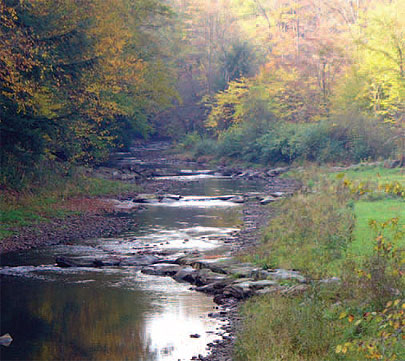WPC Project Helps Portage Creek Heal
Although a massive train derailment in 2006 eliminated nearly all life within Sinnemahoning-Portage Creek, this pristine fishery in Pennsylvania’s north central tier — called the Pennsylvania Wilds — is recovering.
The incident also opened the door to new watershed work by the Western Pennsylvania Conservancy, which began a detailed visual assessment of Portage Creek in July of this year with a grant from the Pennsylvania Fish and Boat Commission. The assessment and related mapping, which will include parts of Cameron, McKean and Potter counties, will be completed over a two-year period.
The Conservancy’s grant was paid from the Fish and Boat Commision’s settlement with Norfolk-Southern. Norfolk-Southern was liable for the wreck that sent carloads of sodium hydroxide into Portage Creek, the larger Driftwood Branch of Sinnemahoning Creek, and the main stem of Sinnemahoning Creek, killing trout, macro-invertebrates and other aquatic life.

Fourmile Run at Portage Creek after an instream restoration project.
A comprehensive visual assessment had never been done in the Portage Creek watershed, and will provide WPC and its partners with vital baseline data and help identify both problems and opportunities. It will also assist WPC in implementation of the Sinnemahoning Creek Watershed Conservation Plan, which addresses management recommendations identified for the larger 1,050 square mile watershed.
“We will eventually walk all of Portage Creek and its tributaries — altogether about 160 miles,” said Mark Killar, WPC watershed manager for the West Branch of the Susquehanna River. “We are looking at aquatic habitat as well as stream banks, which are destabilized in places.” Habitat in Portage Creek is excellent in places with in-stream structures, runs, riffles and pools, and less productive where alterations were made to accommodate the railway and Rt. 155, Killar said.
The Fish and Boat Commission is sampling fish populations on upper Portage, which is Class A wild trout water, and on the lower reaches, which are stocked. Class A water is based on high biomass of wild trout.
Effects of the derailment have diminished, with the Pennsylvania Department of Environmental Protection removing contaminated soil and aquatic insect life returning to near-normal. Wild trout are slowly recolonizing, said Scott Carney, Fish Commission habitat management chief. “It’s probably going to take a couple of more years to see those populations totally rebound, but we are confident they will.”
The visual assessment will be pivotal in the watershed’s continuing recovery, said Carney. “We can make improvements that should enhance trout populations. With better habitat, we might eventually be able to expand the Class A stretch. Class A status ensures the highest protection from natural gas drilling and other impacts.”
The visual assessment also includes identifying land owners along both Portage Creek and the Driftwood Branch, to help make future contact with streamside property owners easier, should the need arise.
WPC will use the Environmental Protection Agency’s visual assessment protocols, as well as GPS, to identify and mark problem areas and digitally map the watershed.
“There’s a checklist of different features you look for and score from good to bad...like how much stone and cobble is in the stream, how much sedimentation is there, how much cover for fish and macro-invertebrates exists, how well-vegetated the banks are and whether people are mowing right up to the edge of the stream [which negatively affects water quality],” Killar said.
The Conservancy will also coordinate its work with the McKean, Potter and Cameron County conservation districts.
